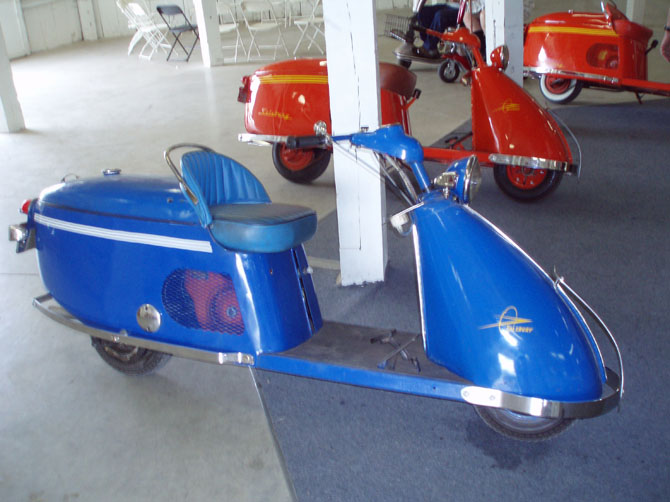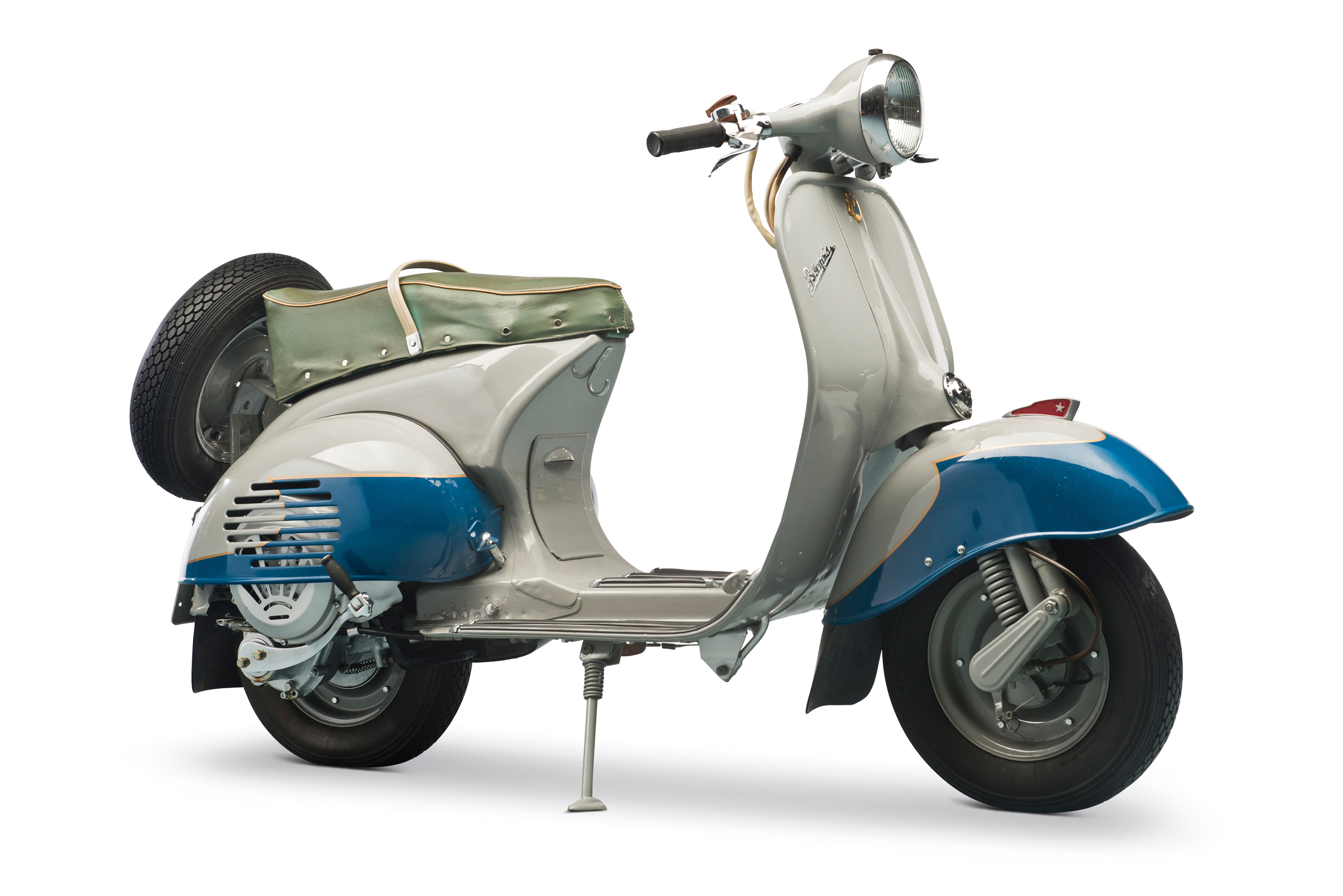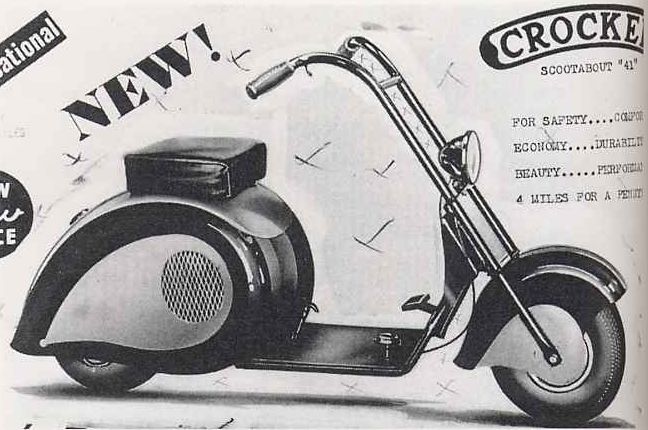10 collectible scooters you definitely need in your life
The depth of common knowledge of vintage scooters in the United States pretty much stops at Vespa and Lambretta. They are far from the only names in the game, but, to be fair, you can’t talk about vintage scooters without focusing on a few of those truly special machines.
In many parts of the world, scooters are cheap, almost disposable, transportation—machines meant to be used and abused without a second thought. But an enthusiastic community of true aficionados prizes beyond-the-mainstream machines from German, Japan, Russia, and the United States, and the best of them command big money.
We talked to a few serious collectors to compile a list of scooters of the most desirable two-wheelers available today. Our panel includes Jay Holdash, a Massachusetts collector who owns a small stable of scooters from Europe, Japan, and the U.S.; Tom and Anna Giordano of New York, who own some of the rarest rides in existence; and Scott Doering, who lives in New Jersey and focuses exclusively on the rare Jet Age-styled Salsbury scooter built in the U.S. from 1947 to 1950.
1947-1950 Salsbury Model 85

The Salsbury Model 85 was the second scooter in E. Foster Salsbury’s lineup after the 1936 Motor Glide, the world’s first commercially viable motor scooter. The Motor Glide was an instant success, and rivals like Cushman and Moto Scoot quickly followed it with their own models. The Model 85, available in Standard and Deluxe trims, were out of this world. “The Buck Rogers rocketship of motor scooters,” says Jay Holdash, who owns a Standard restoration candidate for which he spent years searching.
“From a valuation standpoint nicely restored scooters can bring up to $15,000. Recently a superbly restored Model 85 and sidecar sold at auction for $22,000,” says Scott Doering, who is the International Salsbury Restorer’s Society webmaster. “If you are looking to acquire one it is best to find one that is complete. Parts are hard to come by. There are a couple guys in the hobby who have amassed large spare parts collections, but other than that a collector is on his own.”
1953-1964 Zundapp Bella

Parts are more readily available for the Zundapp Bella. Zundapp, BMW’s biggest motorcycle competitor in Germany after WWII, started building scooters in 1953. “It’s a fantastic German machine,” says Jay Holdash. “Tough, dependable, beautiful, comfortable.”
The Bella used a 146cc or a 198cc two-stroke engine. Unlike most scooters, which used ten- or even eight-inch steel wheels, the Bella rolled on 12-inch cast aluminum wheels that were a lot less likely to get swallowed by pothole on rough roads. Early bikes featured an undamped, telescopic front fork, but Zundapp soon ditched it for a more sophisticated Earles-type leading link fork with a shock absorber on the left side.
Zundapp built 150,000 Bellas over ten years, which pales in comparison to Vespa, but the popularity of the Bella and the similar Heinkel Tourist fuels a relatively robust parts market. “The Bella interest groups in Germany have put a lot of Bella parts back into production,” says Tom Giordano.
1965-1967 Fuji Rabbit Superflow S601

The Fuji Rabbit holds a unique position in American automotive history. Malcolm Bricklin started selling the scooters, which were built by Subaru’s parent company, in 1966 before offering the Subaru 360 when Fuji couldn’t fill enough Rabbit orders.
Although Fuji offered several different Rabbits, the 200cc two-stroke Superflow S601 is the one to have. It offered a slew of features, including an electric starter and an automatic transmission with an automotive-style fluid torque converter for imperceptible shifting, and rear air suspension.
“Truly the Cadillac of motor scooters,” Holdash says. “They’re slow off the line, but they have plenty of power for cruising, even with two riders. It’s the perfect combination of luxury and usability.”
Despite being produced for just three model years, Rabbit Superflow 601s regularly come up for sale and aren’t ridiculously expensive. In fact, prices have receded somewhat because parts are getting tougher to find, says Tom Giordano.
1957-1959 Lambretta TV175 Series 1

Innocenti was Piaggio’s biggest rival in the scooter biz, and together the two companies cranked out millions of Lambretta and Vespa models over the years. Most of them are thoroughly run-of-the-mill, but the Lambretta TV175 series of bikes that Innocenti introduced in 1957 are something special.
The TV175 set the benchmark for Lambretta’s styling, and the drivetrain was no less impressive. It featured an enclosed chain drive and a four-speed gearbox. “Lambretta pulled out all the stops on this one,” Holdash says. “Drop-dead beautiful styling, a radically different engine design from previous models, it was a real leap to the future.”
Ah, but they weren’t entirely reliable, and were in their day considered something of a failure. Yet collectors prize them as a pinnacle in scooters. “They’re hard to find now, and highly sought after by collectors,” Holdash says. “A correct restoration is very challenging due so many unique parts that weren’t shared with other models.”
Prices reflect their desirability. “TV175s can go for $2500 as barn finds, $3500 as unrestored runners, and $6000-plus fully restored,” says Tom Giordano. An exquisitely restored TV175 Series 1 sold at Bonhams’ Alexandria Place Sale in London last September for $11,420.
1955-1958 Vespa GS 150, models VS1-VS4.

The GS 150 VS5 scooters that Vespa sent to the U.S. were, as Holdash notes, wonderful machines. But the earlier models are more rare and, to his mind, represent the pinnacle of classically styled Vespa motor scooters.
There were other ideas for scooters at the time, like Lambretta and Zundapp suggest. Those scooters hung steel bodywork off of a tubular steel backbone, and as a result end up looking blocky and— for lack of a better word—masculine. The Vespa is the classic scooter design and it comes from the fact that it’s a monocoque design. The pressed steel bodywork is the frame itself, and the engine and transmission are one single cast unit. The only additional bodywork is the front fender and the rear engine cowl and luggage compartment, all gorgeously sculpted and emblematically Italian.
The GS 150 goes those early Vespa scooters one better, with bodywork even rounder and more voluptuous than the standard models, topped by a long, two-up seat in place of the single saddle and passenger pad. At the time, lesser Vespas had chrome handlebars with exposed shifter and brake cables, but the GS 150’s handlebars were a cast aluminum unit which hid the cables in a tunnel that ran through the body. All Vespas got these handlebars after 1958. Mechanically, it got the first four-speed gearbox in a Vespa, plus higher compression and a bigger 23mm carburetor for eight horsepower, versus the lesser bike’s 5.4.
The “VS” is indicated at the beginning of the scooter’s frame number: VS1 came in 1955, and VS4 ended up on bikes produced in 1958. The VS5 arrived in 1961. Tom Giordano says that the GS market remains strong even as the market for lesser Vespa models recedes. “Today, the Allstates (rebadged Vespa scooters sold through Sears in the 1950s and 1960s) and project vintage Vespas in barn-find condition are more like $500 to $1000 max. Running and driving, but unrestored, maybe $1500.” On the other hand, a GS project, could easily run in the $2000 to $3000 range, needing full restoration.
1954-1958 Rumi Formichino

Italians seem to love naming scooters after bugs. After all, Vespa is Italian for “wasp,” and that’s exactly what they look like. Formichino means “little ant,” and that’s pretty much exactly what you get with these rare bikes built from 1954 to 1958. They enjoyed a rabid fanbase in their day, due to their tremendous success in sprint and endurance racing, including the 24 hour Bal d’Or at Montlhéry, France.
These wildly overengineered machines use cast aluminum chassis sections. The 125cc horizontal, air-cooled twin was a stressed member of the chassis. Despite the aesthetic qualities of some of their engines, most scooter manufacturers were hiding their engines behind sheetmetal cowls. The Formichino’s attractive aluminum engine cases are proudly on display between the rider’s feet.
Rumi offered the Formichino in two models: the standard bike, and the Tipo Sport, which featured a larger carburetor, a less restrictive exhaust and higher compression. “The engine is a watchmaker’s delight, intricate and clever design and a packs a wallop for such a small size,” says Holdash.
Collectors have watched the value of these machines go off the charts, even though the market is dominated by a tiny bunch of passionate enthusiasts. “Twenty years ago, I used to balk at paying $2000 for a good complete project,” says Tom Giordano. “Now you can’t get a good complete project for less than $6000. Runners that used to go for that now go for $10,000 or more. And that’s a normal Formichino, not a Sport model.”
1956-1965 Vjatka VP150

The Vjatka VP150 looks like a photocopy of a Vespa created by a machine running low on toner. In 1956, Russian gramophone manufacturer VPMZ started work on its own motor scooter, essentially reverse-engineering a Vespa. Like the Vespa, it features a steel monocoque with a horizontally-mounted two-stroke single, a three-speed transmission and a fork with the wheel mounted to the side. Despite the similar DNA, the two machines don’t share a single part.
These come up for sale from time to time, but rarely in the United States. The last one we’re aware of sold for just over $4500 in RM/Sotheby sale of the Bruce Weiner Collection in 2013. The Vjatka VP150 & Other Russian Scooters page on Facebook shows a restored example for sale in Poland for €5500, about $6250 in U.S. dollars.
1952 Ducati Cruiser

The Ducati Cruiser is a stunner. Carrozzeria Ghia styled Ducati’s first scooter, which debuted at the Milan Fair in 1952. The engineering was no less remarkable. At a time when every scooter manufacturer used two-stroke engines, the Cruiser featured a four-stroke, overhead valve 175cc engine. It also had a three-speed automatic transmission mounted behind the engine in an aluminum case that looked like a miniature TH350. The Cruiser started with the flick of a switch which, although not unprecedented at the time, was certainly rare.
Ducati built just 1200 Cruisers. A check of all the usual sources (auction houses, eBay, etc.) reveals none for sale at the moment, and nothing to go on in terms of recent sale values.
1953 – 1965 Heinkel Tourist

The Tourist was the other big German two-up touring scooter, along with the Zundapp Bella. These durable machines could carry two people from one side of the country to the other in comfort and style. A Tourist did exactly what when Peter Beagle rode across the U.S. in 1964, an adventure he recounted in his book I See By My Outfit.
Although the Tourist never quite caught on in the states, it was very popular in Germany. Heinkel built 55,000 of the last series alone–the 103 A2, produced from 1960 through 1965. The Tourist still enjoys a healthy following. “Bellas and Heinkels are good value for money for a collector or even a rider who wants something unusual,” says Tom Giordano. “This has a lot to do with parts availability. The Heinkel Club Deutschland is still in existence and can supply anything you need.”
Tourists come up fairly regularly for sale. Last May, a nice, two-owner 1965 103 A2 sold for $5100 on Bring a Trailer.
1941 Crocker Scootabout

The Crocker Motorcycle Company in Los Angeles built some of the most highly coveted two-wheelers of the 20th century. Yet few people know the company also dabbled in scooters with the 1941 Crocker Scootabout. The step-through scooter, designed by Al Crocker and distributed by Floyd Clymer, featured one-up seating, a centrifugal clutch, and a 2.3-hp engine hidden behind a teardrop-shaped cowling pressed from sheet metal. The original press release boasted about the Scootabout’s “Tow-Back attachment is available for use in attaching the unit to car bumpers.”
Want one? Pffft. Good luck. “Fantastic art deco styling, and super rare,” Holdash says. “My favorite American scooter other than the Salsbury Model 85. Rare to the point I’ve never seen one in person.”


looking for dmw deemster can you help one sold on ebay last in 2021
How much is a unrestored scooter ( made in Italy by Piaggio &C model # 788.84331 worth we purchased in early 1960’s
Hi I’m looking for help I have a very old moped with the engine made by villas engineering Wolverhampton I no its pre 1966 can anyone help please as I have the job of restoring
Kind regards Simon
Rak a tak blue collapsible electric scooter blue color blue and blue vintage Dana
Need parts
??? $
4024503917
Anyone looking for a really beautiful restored older scooter should contact a Richard Reynolds Grand Rapids, Michigan address, but lives in Walker, Michigan. I have seen his work and it is outstanding and is unbelievable. He starts with scraps of junk and beautifully restores with mainly original parts or as much as he can get and makes them just like new. He sells to all over the USA.
Another fantastic and rare scooter with a surprisingly good performance and spares availability is the Velocette Viceroy, a flat-twin 200cc two-stroke with sweeping lines and an electric starter, built from 1960-64.